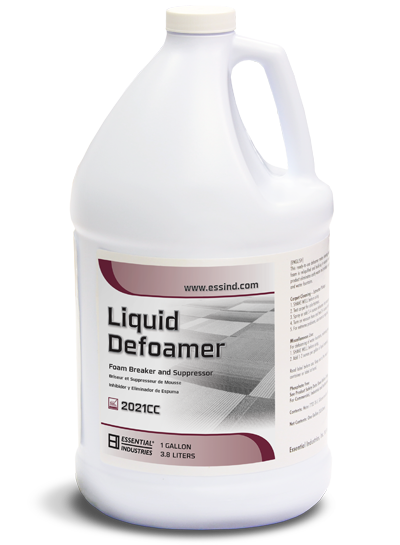How to Choose the Right Chemical Defoamer for Your Specific Application
How to Choose the Right Chemical Defoamer for Your Specific Application
Blog Article
Just How a Chemical Defoamer Can Enhance Effectiveness in Your Operations and Processes
In today's affordable commercial landscape, functional performance is critical, and the function of a chemical defoamer can not be neglected. By resolving foam-related challenges that interfere with procedures, defoamers not only promote smoother operations but additionally add to cost financial savings and boosted product high quality.
Understanding Chemical Defoamers
Chemical defoamers play a crucial function in various commercial processes by successfully protecting against and decreasing foam development. Foaming can cause functional inefficiencies, boosted manufacturing expenses, and endangered item top quality. Defoamers are specialized chemical ingredients made to interrupt the security of foam bubbles, consequently enabling smoother handling and boosted efficiency throughout a number of markets, consisting of food and beverage, drugs, and wastewater treatment.

These representatives normally include surfactants, oils, or polymeric compounds that lower the surface area tension of the liquid, facilitating the collapse of foam. The system by which defoamers run frequently involves the destabilization of foam structures, enabling quicker water drainage of liquid and the release of caught air. Various formulas are tailored to certain applications, considering elements such as compatibility with the system, temperature, and the nature of the fluid being dealt with.
Comprehending the make-up and performance of chemical defoamers is important for choosing the ideal product for a provided application. By optimizing defoamer choice based on procedure needs, markets can boost functional performance, minimize foam-related challenges, and ultimately improve general productivity.
Advantages of Utilizing Defoamers
Making use of defoamers can significantly boost operational efficiency across various sectors by effectively alleviating foam-related concerns. The presence of foam can disrupt processes, bring about enhanced downtime, decreased productivity, and prospective quality deterioration in end products. Defoamers help combat these challenges by breaking down foam frameworks, thus permitting for smoother operations.
One of the key benefits of making use of defoamers is the reduction of waste and remodel. By decreasing foam development, defoamers enhance the consistency of procedures, making sure that products are made use of successfully. This not just lowers operational costs but likewise contributes to sustainability campaigns by lowering source usage.
Additionally, defoamers can improve product quality. In making settings, excessive foam can cause disparities in product characteristics, influencing customer contentment. By regulating foam levels, defoamers assist preserve the preferred physical homes of items.

Applications in Various Industries
The effectiveness of defoamers expands across a vast array of sectors, where their application addresses particular foam-related challenges integral to every field. In the food and beverage market, defoamers are vital for optimizing manufacturing procedures, such as developing and dairy products processing, where too much foam can hinder circulation rates and lower performance. By minimizing foam, these representatives enhance product top quality and uniformity.
In the chemical manufacturing field, defoamers are used in procedures like paint manufacturing and wastewater therapy. Right here, they protect against foam formation that can disrupt mixing and different phases, therefore enhancing the overall performance and performance of operations.
In pharmaceuticals, defoamers play a vital function in the formulation of fluid drugs, making certain appropriate dosage and security by controlling foam during mixing and storage. (Chemical Defoamer)
In addition, in the farming industry, defoamers are made use of in pesticide formulas to improve application efficiency and decrease waste.
Choosing the Right Defoamer
Choosing the appropriate defoamer is essential for attaining ideal efficiency in various applications. The choice procedure ought to start with a complete understanding of the details issues at hand, image source including the sort of foam existing, the processing problems, and the chemical compatibility with other solution components.
Defoamers are created from a range of materials, consisting of silicone, mineral oils, and fats. Determining the right composition is essential, as various materials display differing effectiveness in varied atmospheres. Silicone-based defoamers are often preferred in high-temperature applications due to their stability, while organic defoamers might be a lot more suitable for water-based systems.
Additionally, think about the defoamer's influence on the final product. Some formulations can alter the practical or aesthetic residential or commercial properties, making it critical to pick a defoamer that fulfills item requirements without endangering top quality.
Examining is one more important action in choosing a defoamer. Small trials can provide valuable insights into the defoamer's efficiency, permitting adjustments before full-scale execution. By thoroughly assessing these elements, companies can boost efficiency and make sure that the defoamer properly fulfills their functional needs.
Finest Practices for Application
Applying a defoamer successfully calls for cautious preparation and adherence to finest methods to optimize its performance. Conduct an extensive assessment of the details application and foam qualities. Comprehending the kind and resource of foam will certainly assist the choice of the most view publisher site suitable defoamer formula.
Following, develop the optimal dosage (Chemical Defoamer). Start with a small trial to figure out the minimum effective concentration, as extreme use can bring about damaging results on item top quality or operational performance
Tracking and adjusting the application method is crucial; make sure that the defoamer is introduced at the right factor check this site out at the same time for maximum impact, such as during mixing or quickly after foam formation.

In addition, maintain clear interaction with all relevant personnel to make certain constant application methods and to share insights on efficiency end results.
Conclusion
In final thought, the utilization of chemical defoamers plays a critical duty in boosting operational performance throughout varied markets. Inevitably, the consolidation of defoamers right into commercial procedures fosters integrity and contributes to overall performance enhancement.

In the food and beverage sector, defoamers are essential for maximizing manufacturing processes, such as developing and dairy processing, where extreme foam can prevent circulation rates and lower performance. Silicone-based defoamers are commonly favored in high-temperature applications due to their security, while natural defoamers might be much more appropriate for water-based systems.
Report this page